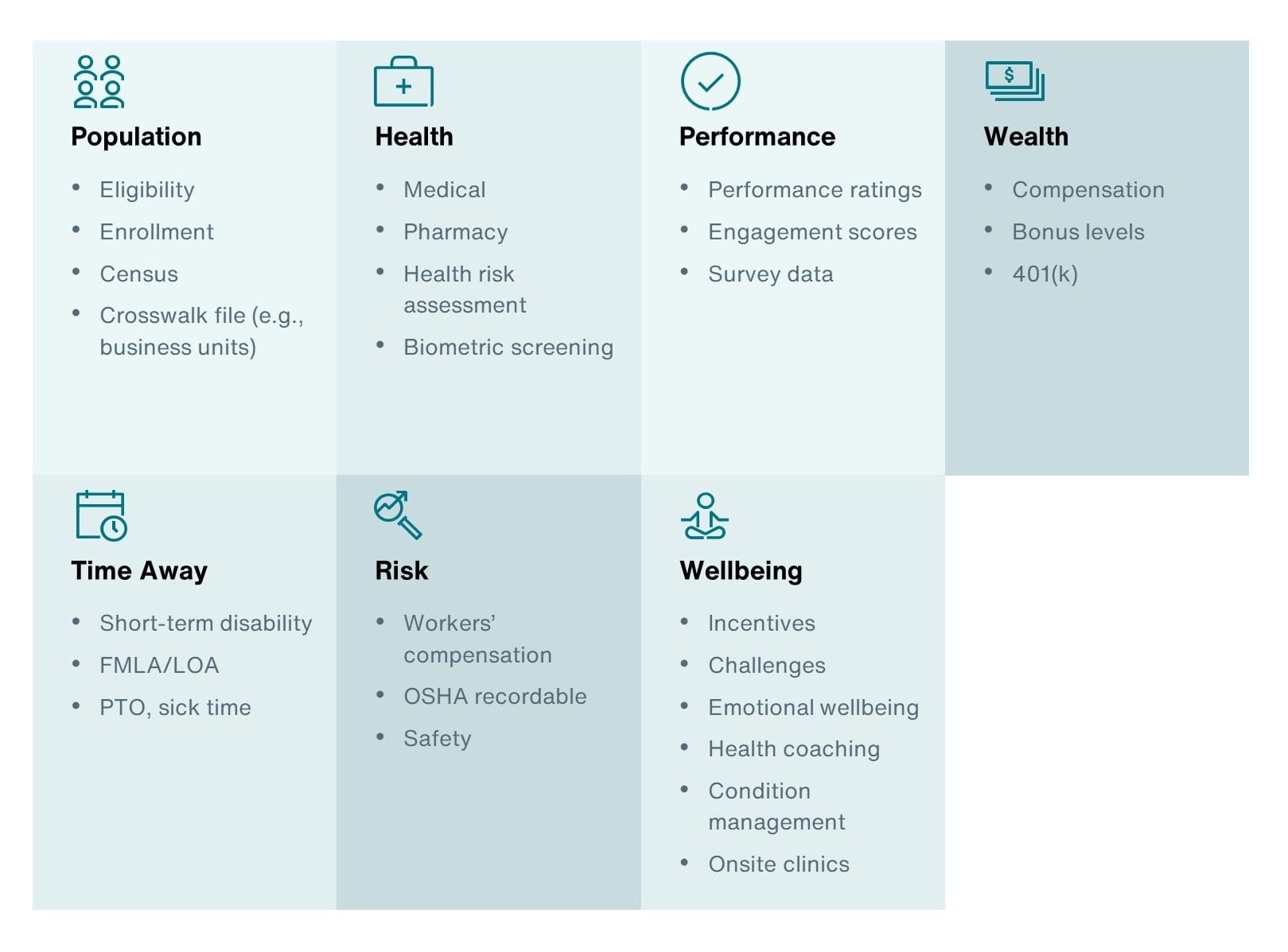Integrating Workforce Data to Uncover Hidden Insights

CHROs are using workforce data and insights to craft solutions that address organizational challenges and elevate their people.
Key Takeaways
-
Understanding the underlying causes of workforce issues and their effects on employee health, wellbeing and productivity is a growing business priority.
-
The right data can help analyze the population, identify top business issues and create customized solutions to address specific needs.
-
CHROs and business leaders should work together to make better informed investment decisions to remain competitive in the talent market.
Ask senior leaders what ranks highest on their agenda, and workforce considerations are likely to sit at or near the top. Concerns about employees’ health, wealth, wellbeing, safety, performance and engagement are perennial and paramount. While it may fall primarily to human capital and finance leaders to design and deliver employee benefits solutions, business leaders across departments have a vested interest in building a high-performing, resilient workforce and a supportive work environment.
Understanding the unique organizational dynamics at play across a company and within specific employee segments is inherently complex, especially in large organizations with numerous employees. Leaders often struggle to identify the underlying causes of workforce issues and their effects on the business and its employees. Slumping productivity or increased safety risks may not be correlated to underused time-off benefits, for instance.
When it comes to benefit programs and workforce solutions, determining what is working and what warrants additional investment is equally important yet challenging. For example, senior leaders may see trends, such as employees’ changing time-off patterns or lowering spending on chronic-condition management, but not connect those trends to last year’s investments in additional wellbeing programs. These types of challenges — including difficulty seeing the important interconnections coursing through organizations — are exacerbated by siloed business units and functional teams, which is a widespread issue. In a survey of more than 1,000 business leaders in the U.S. and UK, nearly four out of five respondents (79 percent) said teams throughout their organizations are siloed.1
Fortunately, business leaders needn’t fly blind. More than ever, large organizations are awash in data about their employees and, to a lesser degree, their dependents. Indeed, many companies have been successful at analyzing discrete data sets — especially health data and compensation data — and using the resulting insights to inform business decisions. Very few, however, have taken a top-down, structured and coordinated approach to aggregating and analyzing workforce data, uncovering hidden insights and developing solutions that can then be implemented with relevant groups. However, eight in 10 decision makers said reducing data and information silos is a top priority for their organizations.1
Organizations Can Use Employee Data to Make Better Decisions

An Integrated Analytics Intelligence Approach
Chief human resources officers (CHROs) can initiate such a coordinated effort with tools like Aon’s Integrated Analytics Intelligence (IAI) solution.IAI relies on a consultative, project-based approach to aggregate sensitive data, analyze the population, identify top issues affecting the business and create customized solutions to address specific needs. Although leaders typically begin an IAI project with questions or concerns about particular workforce issues they hope to solve, the process itself frequently uncovers other interesting observations upon which they can act.
Enlisting key stakeholders in talent and benefits, workplace safety, finance, technology and risk management to contribute relevant data and expertise is crucial to ensuring a truly interdepartmental effort.
Analysts then examine the aggregated, anonymized data to discern insights about the overall population. They use filters, including geography, business unit, job type, chronic condition and absenteeism, to further identify which subgroups align with the challenges. Combining filters provides an even more nuanced view and can help tease out root problems.
Using data and analysis allows clients to better understand connections between health conditions and safety and risk, employee performance and time away from work, social determinants of health, financial wellbeing and so much more.
Improved Health Outcomes Based on Rigorous Data and Analysis
Using resources like IAI for data analysis can support organizations in a variety of ways, including:
- Improve performance and cost management by mitigating group health risks. Health risks such as high blood pressure, lack of sleep and high reported stress levels exacerbate risk for chronic conditions. This can worsen employees’ health, contribute to low performance and cost the employer more in insurance spending. In this case, an IAI analysis identifies cohorts with these health risks (for example, based on age, working hours or job role). Targeted actions could include free blood pressure screenings or discounts on personal wellness devices to all employees to mitigate health risks.
On the other hand, high performance may be shown to connect to a different set of risks. High performers may also correlate with high blood pressure. They may not take their allotted time off, thus increasing their risk of burnout and attrition. Targeted actions could include encouraging leaders to set an example by creating an environment in which taking time off is standard practice. Companies can also set flags in systems for employees with excessive unused time off. - Enhance employee engagement through more personalized wellbeing. Employees often do not take advantage of the wellbeing programs offered to them such as emotional support and chronic-condition management. A data analysis can identify which population segments received and responded to outreach about programs, engaged in programs and why they engaged. The responding action could be adjusting communications approaches with an eye toward increasing engagement to boost prevention, reduce risks and achieve costs savings.
- Strengthen retirement readiness by efficiently refocusing existing budget. Companies typically match employee contributions to retirement savings up to 3 or 5 percent a year and plan their budgets accordingly. A deep dive into the data may find employees are not sufficiently saving for retirement, the company could consider restructuring this benefit and budgeting for it. For example, the company could contribute 1 or 2 percent to every employee’s retirement savings irrespective of their own contributions. It could also auto-enroll employees in retirement savings with the option of opting out.
- Identify and mitigate workplace safety and health risks. Analyzing employee safety data and occupation-driven disability claims could reveal insights such as a link between safety incidents and chronic health conditions (e.g., musculoskeletal, mental illnesses). By developing an integrated strategy to improve workplace safety, an organization could address two issues with the same root cause. Moreover, a data analysis could also help the company pinpoint the underlying drivers of safety risks, such as geographic locations, job types and susceptible body parts. The company could then measure and quantify the impact of health conditions on the performance and productivity of employees. Stakeholders in health, wellbeing and safety groups could work together to devise integrated, holistic solutions to mitigate safety and health risks and improve productivity.
Although tools like Aon’s IAI rely on a structured approach and methodology, companies have wide latitude to adjust data sources, analytics and solutions to meet their unique needs. The power lies in uncovering — often for the first time — the insights hidden in a company’s data that can inform business actions and elevate workforces.
With a much richer understanding of workforce data, CHROs and business leaders can work together to make investment decisions that are better informed and more effectively compete in the talent marketplace.
1 The Crisis of Fractured Organizations, Forrester Research, December 2022.
General Disclaimer
This document is not intended to address any specific situation or to provide legal, regulatory, financial, or other advice. While care has been taken in the production of this document, Aon does not warrant, represent or guarantee the accuracy, adequacy, completeness or fitness for any purpose of the document or any part of it and can accept no liability for any loss incurred in any way by any person who may rely on it. Any recipient shall be responsible for the use to which it puts this document. This document has been compiled using information available to us up to its date of publication and is subject to any qualifications made in the document.
Terms of Use
The contents herein may not be reproduced, reused, reprinted or redistributed without the expressed written consent of Aon, unless otherwise authorized by Aon. To use information contained herein, please write to our team.
Aon's Better Being Podcast
Our Better Being podcast series, hosted by Aon Chief Wellbeing Officer Rachel Fellowes, explores wellbeing strategies and resilience. This season we cover human sustainability, kindness in the workplace, how to measure wellbeing, managing grief and more.
Aon Insights Series Asia
Expert Views on Today's Risk Capital and Human Capital Issues
Aon Insights Series Pacific
Expert Views on Today's Risk Capital and Human Capital Issues
Aon Insights Series UK
Expert Views on Today's Risk Capital and Human Capital Issues
Construction and Infrastructure
The construction industry is under pressure from interconnected risks and notable macroeconomic developments. Learn how your organization can benefit from construction insurance and risk management.
Cyber Labs
Stay in the loop on today's most pressing cyber security matters.
Cyber Resilience
Our Cyber Resilience collection gives you access to Aon’s latest insights on the evolving landscape of cyber threats and risk mitigation measures. Reach out to our experts to discuss how to make the right decisions to strengthen your organization’s cyber resilience.
Employee Wellbeing
Our Employee Wellbeing collection gives you access to the latest insights from Aon's human capital team. You can also reach out to the team at any time for assistance with your employee wellbeing needs.
Environmental, Social and Governance Insights
Explore Aon's latest environmental social and governance (ESG) insights.
Q4 2023 Global Insurance Market Insights
Our Global Insurance Market Insights highlight insurance market trends across pricing, capacity, underwriting, limits, deductibles and coverages.
Regional Results
How do the top risks on business leaders’ minds differ by region and how can these risks be mitigated? Explore the regional results to learn more.
Human Capital Analytics
Our Human Capital Analytics collection gives you access to the latest insights from Aon's human capital team. Contact us to learn how Aon’s analytics capabilities helps organizations make better workforce decisions.
Insights for HR
Explore our hand-picked insights for human resources professionals.
Workforce
Our Workforce Collection provides access to the latest insights from Aon’s Human Capital team on topics ranging from health and benefits, retirement and talent practices. You can reach out to our team at any time to learn how we can help address emerging workforce challenges.
Mergers and Acquisitions
Our Mergers and Acquisitions (M&A) collection gives you access to the latest insights from Aon's thought leaders to help dealmakers make better decisions. Explore our latest insights and reach out to the team at any time for assistance with transaction challenges and opportunities.
Navigating Volatility
How do businesses navigate their way through new forms of volatility and make decisions that protect and grow their organizations?
Parametric Insurance
Our Parametric Insurance Collection provides ways your organization can benefit from this simple, straightforward and fast-paying risk transfer solution. Reach out to learn how we can help you make better decisions to manage your catastrophe exposures and near-term volatility.
Pay Transparency and Equity
Our Pay Transparency and Equity collection gives you access to the latest insights from Aon's human capital team on topics ranging from pay equity to diversity, equity and inclusion. Contact us to learn how we can help your organization address these issues.
Property Risk Management
Forecasters are predicting an extremely active 2024 Atlantic hurricane season. Take measures to build resilience to mitigate risk for hurricane-prone properties.
Technology
Our Technology Collection provides access to the latest insights from Aon's thought leaders on navigating the evolving risks and opportunities of technology. Reach out to the team to learn how we can help you use technology to make better decisions for the future.
Top 10 Global Risks
Trade, technology, weather and workforce stability are the central forces in today’s risk landscape.
Trade
Our Trade Collection gives you access to the latest insights from Aon's thought leaders on navigating the evolving risks and opportunities for international business. Reach out to our team to understand how to make better decisions around macro trends and why they matter to businesses.
Weather
With a changing climate, organizations in all sectors will need to protect their people and physical assets, reduce their carbon footprint, and invest in new solutions to thrive. Our Weather Collection provides you with critical insights to be prepared.
Workforce Resilience
Our Workforce Resilience collection gives you access to the latest insights from Aon's Human Capital team. You can reach out to the team at any time for questions about how we can assess gaps and help build a more resilience workforce.
More Like This
-

Article 6 mins
Leading the Biofuels Transition: Risk Strategies to Cut Through Complexity
Companies aiming to be a net-zero company may face many challenges during the biofuels transition. Read more on risk strategies to cut through complexity.
-

Article 6 mins
DC Pension Schemes: Improving Investment Returns
With DC schemes growing across Europe, many organizations are realizing the importance of ensuring strong performance from their investments. Here’s how asset owners and managers can optimize DC outcomes through the right investment strategy.
-

Article 9 mins
Developing a Paid Leave Strategy That Supports Workers and Their Families
With no federal paid leave law in the U.S., employers have limited guidance in designing equitable and comprehensive paid leave programs to support their workforce. Looking beyond compliance to focus on strategy and values will help create fair and well-designed policies.











































































































































